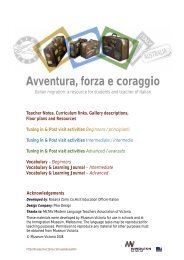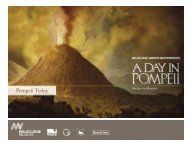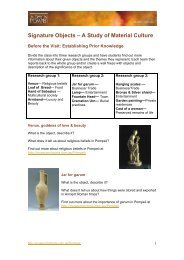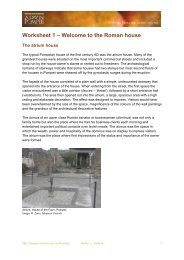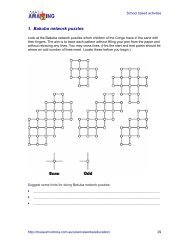Callaloo: the Caribbean Mix in Victoria - Museum Victoria
Callaloo: the Caribbean Mix in Victoria - Museum Victoria
Callaloo: the Caribbean Mix in Victoria - Museum Victoria
You also want an ePaper? Increase the reach of your titles
YUMPU automatically turns print PDFs into web optimized ePapers that Google loves.
<strong>Caribbean</strong> food:<br />
historically delicious!<br />
<strong>Caribbean</strong> food is a vibrant fusion of<br />
cultural <strong>in</strong>fluences reflect<strong>in</strong>g our rich<br />
and complex history.<br />
above<br />
A selection of popular West Indian dishes,<br />
<strong>in</strong>clud<strong>in</strong>g stew, curry and rice.<br />
opposite, clockwise from top<br />
Serv<strong>in</strong>g coo coo, a popular dish made<br />
with cornmeal and okra, at <strong>the</strong> West Indian<br />
Cultural Day, 2008.<br />
Pone, p<strong>in</strong>eapple up-side-down cake and<br />
sweetbread.<br />
The children got <strong>the</strong> best, <strong>the</strong> adults ate <strong>the</strong><br />
rest.’ Spicy food was a normal part of <strong>the</strong>ir fare.<br />
Coo coo and fish; rice and peas.<br />
A favourite soup throughout <strong>the</strong> <strong>Caribbean</strong>,<br />
callaloo cooked with sp<strong>in</strong>ach, crabs and spices.<br />
(See recipe overleaf).<br />
‘Cutters’ or light snacks with doubles and souse.<br />
Photographer: David Loram.<br />
Source: <strong>Museum</strong> <strong>Victoria</strong> <strong>Caribbean</strong> Community<br />
Photographic Collection.<br />
The <strong>in</strong>digenous Caribs and Arawaks made bread, grew<br />
corn, cassava, sweet potatoes, arrowroot, tomatoes,<br />
chillies and o<strong>the</strong>r crops, and ate a wide variety of fruit,<br />
shellfi sh, turtle and game. The Arawaks, grill<strong>in</strong>g <strong>the</strong>ir<br />
meat over open fi res us<strong>in</strong>g frames of th<strong>in</strong> sticks called<br />
barbacoa, gave <strong>the</strong> world <strong>the</strong> word ‘barbeque’.<br />
Sugar cane was <strong>the</strong> basis of <strong>the</strong> <strong>Caribbean</strong> economy<br />
and required <strong>in</strong>tensive labour. European colonisers<br />
<strong>in</strong>troduced many foods from around <strong>the</strong> world to<br />
supplement <strong>the</strong> local food sources: breadfruit, taro,<br />
ackees, okra, yams and planta<strong>in</strong>s from Africa as well<br />
as salt fi sh and rice, to name just a few. Indentured<br />
workers from Ch<strong>in</strong>a and India brought <strong>the</strong>ir chow me<strong>in</strong>s,<br />
curries, rotis and snack foods. West Indian cooks created<br />
many cross-cultural or ‘creolised’ dishes, which were<br />
eaten by everyone.<br />
<strong>Caribbean</strong> recipes cont<strong>in</strong>ue to evolve <strong>in</strong> Australia as<br />
West Indian immigrants experiment with local<br />
<strong>in</strong>gredients. For example, we now substitute sp<strong>in</strong>ach<br />
leaves when mak<strong>in</strong>g our ‘crab and callaloo’ dish. We are<br />
passionate about pass<strong>in</strong>g down our food traditions for<br />
<strong>the</strong> next generation to enjoy!


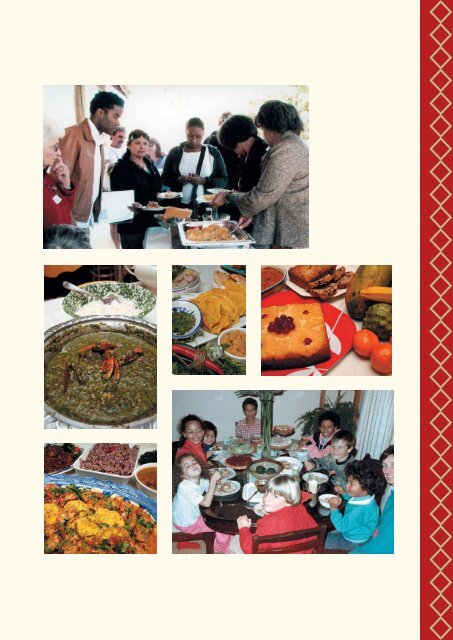
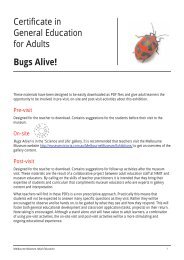


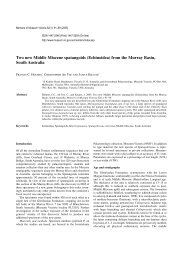
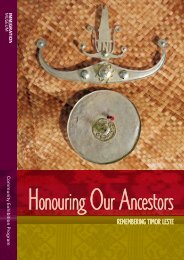
![[PDF] Andiamo a Pompei- Teacher Notes ... la - Museum Victoria](https://img.yumpu.com/16309810/1/190x245/pdf-andiamo-a-pompei-teacher-notes-la-museum-victoria.jpg?quality=85)
